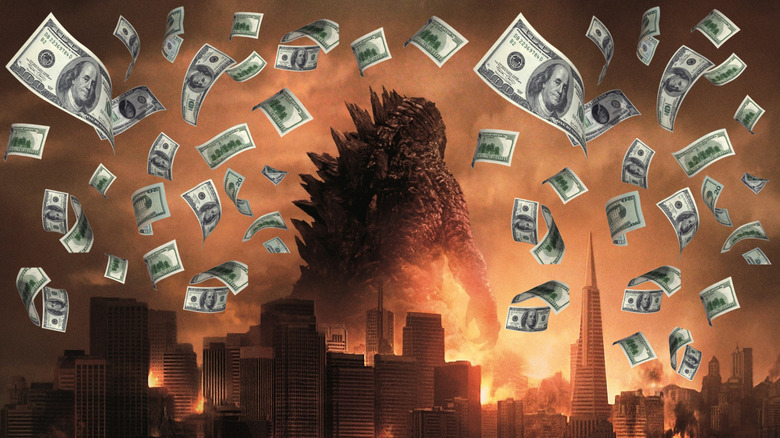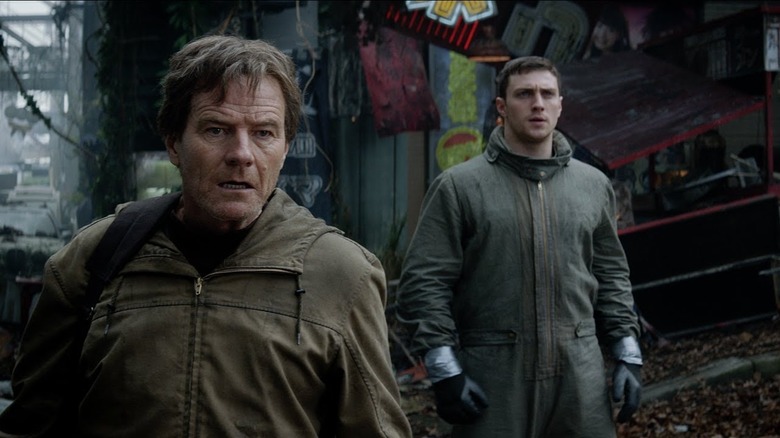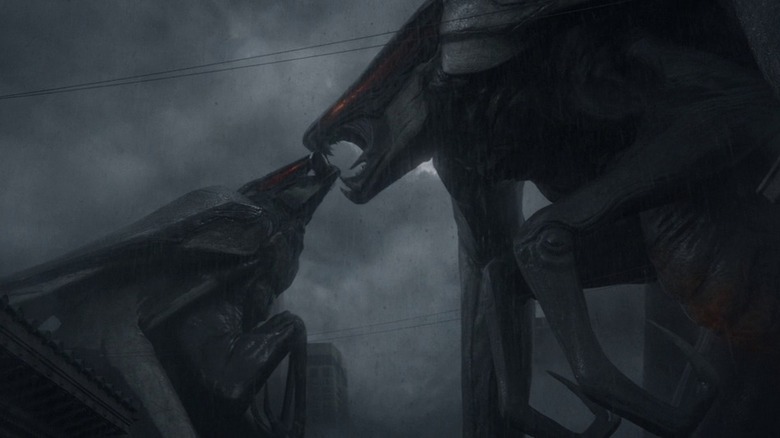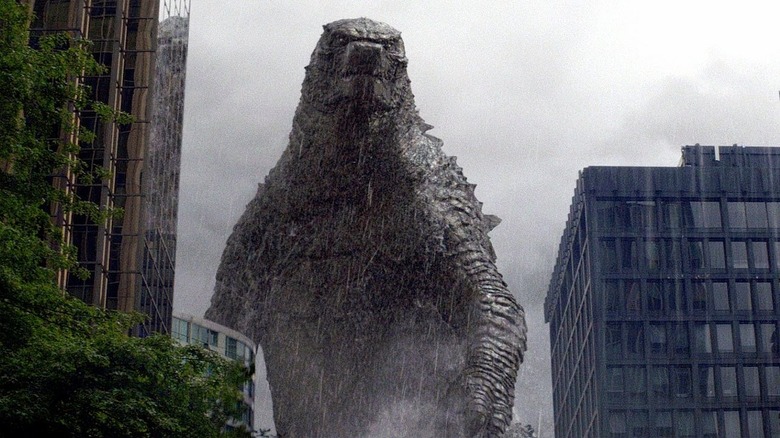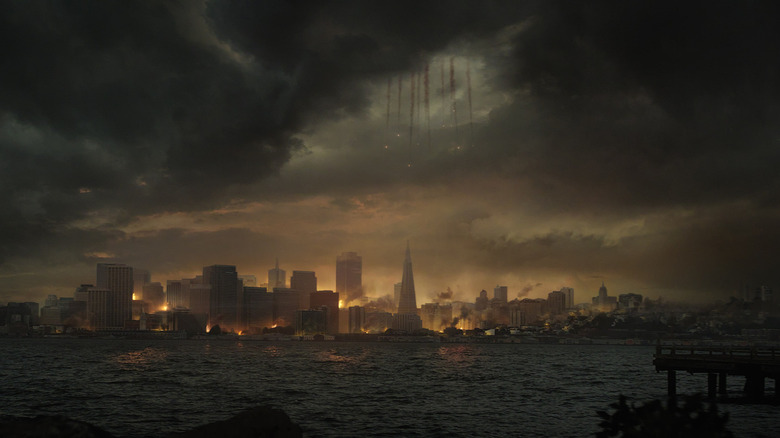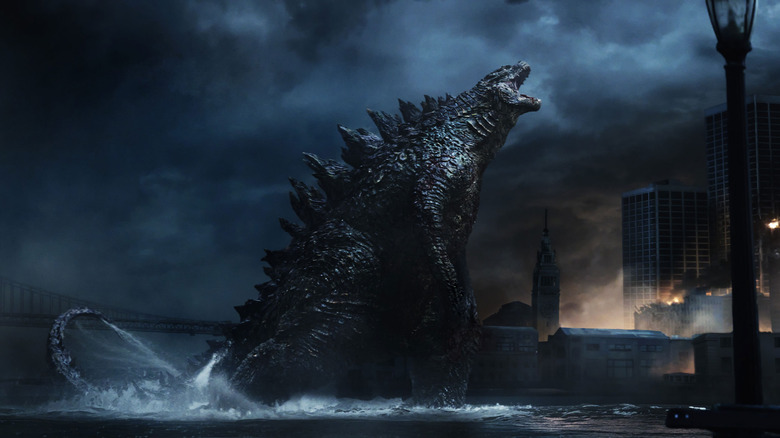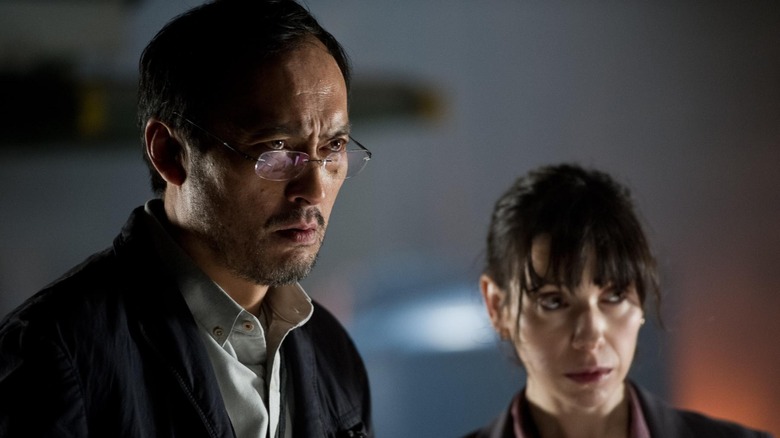2014's Godzilla Was A Divisive Box Office Hit That Paved The Way For So Much More
(Welcome to Tales from the Box Office, our column that examines box office miracles, disasters, and everything in between, as well as what we can learn from them.)
"This isn't art. It isn't even great trash. It's a con game, and we bear the claw marks." That's what critic Rita Kempley wrote for the Washington Post in a particularly scathing review of Roland Emmerich's 1998 movie, "Godzilla." It was the first attempt by Hollywood to bring the classic monster to life in America, and it was a spectacular failure. That's what Warner Bros., Legendary, and director Gareth Edwards were working against while crafting 2014's "Godzilla." Skepticism was built in. They had to prove that a film within this franchise made outside of Japan could work.
They did that and then some.
"Godzilla is one of the world's most powerful pop culture icons, and we at Legendary are thrilled to be able to create a modern epic based on this long-loved Toho franchise," said then-chairman and CEO of Legendary Thomas Tull in 2010 when it was announced that the company was to produce a new film in Toho's beloved franchise. "Our plans are to produce the Godzilla that we, as fans, would want to see. We intend to do justice to those essential elements that have allowed this character to remain as pop culturally relevant for as long as it has." That is all easier said than done, but Tull and Edwards proved to be up to the task.
In this week's Tales from the Box Office, we're looking back at 2014's "Godzilla" in honor of its tenth anniversary. We'll go over how the film came to be, how a scrapped IMAX short indirectly led to this film's creation, how Edwards arrived at his divisive take on the King of the Monsters, what happened when the movie hit theaters, what happened in the aftermath of the release, and what lessons we can learn from it a decade later. Let's dig in, shall we?
The movie: Godzilla (2014)
By 2010, Legendary had already developed quite the reputation, working on Christopher Nolan's "Batman" films, as well as Zack Snyder's "300" and "The Hangover" trilogy, among other big hits. So it seemed like a good home for a new "Godzilla" movie. Prior to Legendary landing a deal with Toho, "Godzilla vs. Hedorah" director Yoshimitsu Banno had been trying to make an IMAX short set within the franchise for American audiences for years. That indirectly paved the way for Legendary to make a new Hollywood feature film, with Warner Bros. coming on board to distribute. Banno, who was credited as an executive producer on the film, explained in 2013:
"I first started to produce an IMAX Godzilla movie of only a 40 minute running time, having obtained the permission to use the characters of 'Godzilla' and 'Hedorah' from Toho. This project developed to a fundamental theatrical movie thanks to the commitment of Legendary Pictures."
The film as we know it centers on Ford (Aaron Taylor-Johnson), who has reunited with his family in San Francisco after returning from the Navy when he is forced to go to Japan to help his estranged father, Joe (Bryan Cranston). Still contending with the tragic death of Joe's wife from years earlier in Japan, they are swept up in a world-rattling moment as giant monsters — identified as MUTOs — wreak havoc around the globe. This awakens the King of the Monsters himself, who winds up on a crash course with the other beasts as humanity watches on and hopes for the best.
Notably, the MUTOs were original creations not pulling from Toho's vast library of monsters connected to the franchise. Instead, the writers (quite a few worked on the script over the years) crafted new threats for Godzilla to battle. The film positions Godzilla as more of a neutral party that is on the Earth to restore balance, rather than an outright villain as he was in the original 1954 "Godzilla" or as a straight-up hero as he would become in later installments.
Gareth Edwards goes from indie to summer blockbuster
Ultimately, Max Borenstein received credit for the script, while Dave Callaham ended up with a "story by" credit. Others, such as David S. Goyer ("Man of Steel") and Drew Pearce ("Iron Man 3") did some script doctoring along the way. As for who would fill the ever-important director's chair? It was Gareth Edwards, who, up to that point, was known best as a visual effects artist. But it was his low-budget debut feature "Monsters" that impressed executives enough to give him a crack at a big-budget blockbuster. Edwards, speaking in 2011, made it clear he had no illusions about the pressure to deliver the goods.
"Everyone involved knows what the film has to be. What's important to me is that, as well as spectacle, you have to give a s*** about what's happening and why."
Edwards made a very deliberate choice to take a "less is more" approach in crafting his take on the franchise – more of a Spielberg-esque "Jaws" approach, with much of the monster mayhem happening from a human POV. This choice would prove to be divisive with certain critics and audience members. It did, however, set the film apart at a time when the franchise was 60 years old. Speaking with Cloture Club in 2014, the filmmaker explained that he and his team tried to ground the craziness of a monster movie by treating it like a natural disaster in some ways:
"There's never really going to be giant monsters that come out of the ocean and smash a city and cause a tsunami and things like this. But, there are events that smash cities and cause tsunamis within nature and war, and so you don't have to think very hard to recall that imagery."
"In a weird way, what you're trying to do subconsciously is remind the audience that as absurd as everything happening is, this stuff does happen," Edwards added. "It's a fantasy but I think all good fantasy has something truthful or real about it, at least below the surface."
Warner Bros. rolls out the red carpet for Godzilla
Naturally, WB and Legendary wanted to keep as much under wraps as they could regarding the production. But it's difficult to keep something as big as "Godzilla" hidden away, as curiosity was particularly feverish as this movie was filming. Bryan Cranston revealed in a 2014 on-set interview that the film's codename did little to hide what was really going on:
"There was a lot of secrecy about the whole thing, and early on they were calling it 'Nautilus,' so I'm going through Canadian immigration, and trying to get my paperwork, and the guy was very efficient. 'What are you working on?' 'A movie.' 'What's the name of the movie?' 'Nautilus.' And that's when his eyes went up. 'You mean 'Godzilla.' And I go,' Yeah.' But even he knew!"
Warner Bros. felt confident in what they had, and two years before the film's release, they did roll out the red carpet for "Godzilla" at San Diego Comic-Con in 2012. Edwards prepared a teaser trailer to give a sense of what he was bringing to the table with the film. While the footage wouldn't wind up in the finished film, it was more than enough to pique the interest of those in the room.
The sheer sense of scale and somber tone set a good expectation for what Edwards would ultimately deliver in the summer of 2014. It was evident that this version of Godzilla was going to be absolutely massive, even relative to other giant monsters in cinema history. It was also crystal clear that all involved were striving to make something radically different than the '98 film that failed to deliver against sky high expectations. The filmmakers weren't going to let that happen again.
The financial journey
Warner Bros. released "Godzilla" in theaters on May 16, 2014. With a $160 million budget, it was orders of magnitude larger than Edwars' "Monsters," which was made for around $500,000. Even so, the studio bet big on his vision. That vision proved to be a bit divisive out of the gate. While some critics, such as Germain Lussier writing for /Film in 2014, praised the film for its unique human POV, the relative lack of monster mayhem left others wanting. But the conversation around this one was indisputably more positive than it was for Emmerich's ill-fated take on the franchise.
Fortunately, WB and Legendary's faith in Edwards' vision was rewarded in short order as the film proved to be a sizable hit out of the gate. On its opening weekend, the much-anticipated blockbuster pulled in $93.1 million, easily topping the charts. Wisely, no new major competition decided to go up against the King of the Monsters. That just left "Neighbors" in its second weekend and "The Amazing Spider-Man 2" in its third weekend to fend off.
The only bad news is that "Godzilla" fell off a cliff domestically in its second weekend, dropping 67% with a $30.9 million second frame as "X-Men: Days of Future Past" entered the fray with a $90.8 million debut. Even so, we're dealing with a franchise that has mass, global appeal and that proved to be the key to its success.
The film finished its run with a respectable $200.6 million domestically to go with a whopping $328.4 million internationally for a grand total of $529 million worldwide. It finished as the 14th biggest movie of 2014, coming in above "Rio 2" ($498.7 million) and behind Clint Eastwood's runaway hit "American Sniper" ($547.6 million). Earning 3.3 times its budget was more than enough to call this one a major success, paving the way for not just a sequel, but an entire cinematic universe full of monsters.
The MonsterVerse is born
Yes, Warner Bros. and Legendary quickly hatched plans for "Godzilla 2," which would eventually take the form of 2019's "Godzilla: King of the Monsters." But the studios quickly realized there was potential for more here. So, the planned "Kong: Skull Island" was moved from Universal Pictures to WB, with the idea being that they would take place in the same universe. With that, what we now know as the MonsterVerse was born.
Keep in mind, around this same time, Marvel was having ridiculous success with "The Avengers" films, and cinematic universes were all the rage. The problem is that many studios put the cart before the horse and the results were disastrous. Warner Bros. experienced this with another franchise by going all-in on Zack Snyder's vision for the DC Universe, which came to a spectacularly disastrous head in 2017 with "Justice League." The MonsterVerse, on the other hand, didn't even see a second film hit theaters until 2017 when "Skull Island" debuted. That film was a resounding success, pulling in $568 million against generally favorable reviews.
While "King of the Monsters" ($383 million worldwide/$170 million budget) was a step in the wrong direction, the franchise has since flourished. Director Adam Wingard's "Godzilla vs. Kong" helped revive movie theaters in the pandemic with $467 million worldwide. Wingard returned with this year's "Godzilla x Kong: The New Empire," the biggest "Godzilla" movie ever with $560 million to date (and counting).
It's been slow but steady with the MonsterVerse, consisting of just five movies across ten years. But the audience is loyal and the pace has allowed audiences to remain excited for each installment. Yes, the tone had wildly drifted from Edwards' semi-grounded, gritty approach, but he unquestionably set the stage for one of the most successful cinematic universes of the modern era.
The lessons contained within
For the larger MonsterVerse franchise, it's remarkable that Warner Bros. and Legendary have managed to exercise such discipline. Rather than rush out a movie every year and a bunch of TV shows (one TV show has been sufficient thus far), they've played the slow and steady game. It has worked very well. Other franchise-obsessed studios would do well to learn from what has been accomplished here. While other universes have flamed out, Godzilla and his fellow monsters remain standing with a bright future before them.
All around, "less is more" seems to be the big lesson to take away from the success of "Godzilla." Opinions vary on the film to this day, and there are decisions that can be called into question, such as killing off Bryan Cranston's character so early on. But there is no denying that taking a reserved approach to the monsters in the film helped it stand out. Edwards, speaking to Den of Geek in 2014, said it better than I possibly could:
"It's a fascinating thing, if you look at the timeline of cinema — and maybe this is showing my age — but there's a specific point where digital effects arrived. And if you look at horror and action, like my favorite films, like 'Aliens' or 'Close Encounters' or 'Jaws,' they're movies that couldn't show everything. They're so powerful as a result, and there's an important lesson for filmmakers there, which is that sometimes, less is more. And sometimes, more is more."
In the age of CGI and inflated budgets, "more is more" is tempting. But less can certainly be more, and that's worth remembering. More doesn't automatically equal better.
